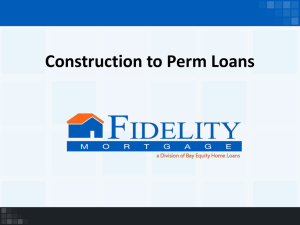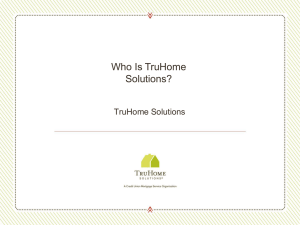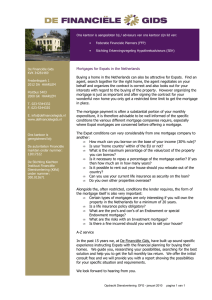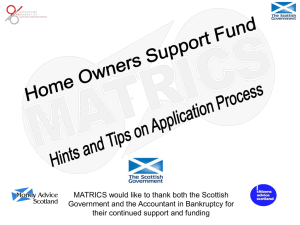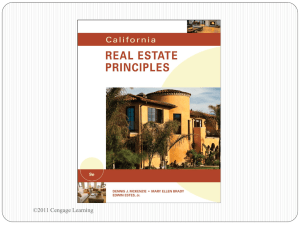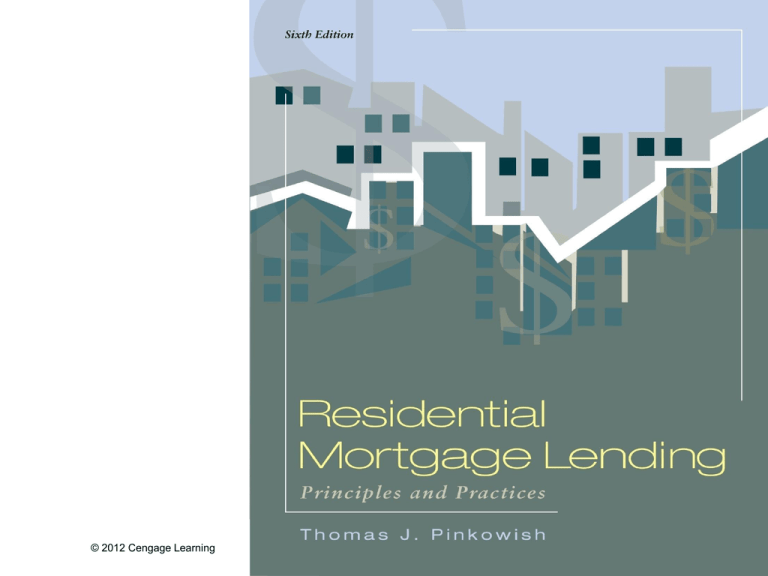
© 2012 Cengage Learning
Residential Mortgage Lending:
Principles and Practices, 6e
Chapter 11
Compliance
© 2012 Cengage Learning
Objectives
• After completing this chapter, you should be able to:
– List the major rules and regulations impacting mortgage lending.
– Discuss the nine prohibited bases of ECOA and discuss discrimination
in lending.
– Discuss the usage of adverse action.
– Understand the impact of recent federal regulations on lenders,
consumers, and the industry.
– Explain how the Right to Rescind (Cancel) works.
– Understand how compliance regulations impact lender behavior and
activity.
– Become familiar with the forms as demonstrated in the chapter.
© 2012 Cengage Learning
Rules & Regulations
• Fair Housing Act (FHA).
• Equal Credit Opportunity Act (ECOA).
• Truth in Lending Act (TILA)
– Home Ownership and Equity Protection Act of 1994 (HOEPA)
– Home Equity Consumer Loan Protection Act
•
•
•
•
•
•
•
•
•
Real Estate Settlement Procedures Act (RESPA)
Mortgage Disclosure Improvement Act (MDIA)
Flood Disaster Protection Act (FDPA)
Homeowners Protection Act of 1998 (HPA)
Fair Debt Collection Practices Act (FDCPA)
Home Mortgage Disclosure Act (HMDA)
Community Reinvestment Act (CRA)
Secure and Fair Enforcement for Mortgage Licensing Act of 2008 (SAFE)
Dodd-Frank Wall Street Reform and Consumer Protection Act (DFA)
© 2012 Cengage Learning
© 2012 Cengage Learning
ECOA “Naughty Nine”
1.
2.
3.
4.
5.
6.
7.
8.
9.
Sex
Marital Status
Age
Race
Color
Religion
National Origin
Receipt of income from a public assistance program
Good faith exercise of any right the applicant has under the
Consumer Credit Protection Act (or applicable state law).
© 2012 Cengage Learning
FAIR CREDIT REPORTING ACT
• Regulates the activities of consumer reporting
agencies and users of consumer credit reports,
and is enforced by the Federal Trade
Commission.
• Also describes how a lender must communicate
with a consumer if an application is denied or
adversely affected because of information on a
credit report or from another source.
© 2012 Cengage Learning
TRUTH IN LENDING ACT
• The basic purpose of this legislation is to
provide consumers with an easily
understandable means of comparing the credit
offerings of various lenders.
• The desired result is that consumers will then
shop for the most favorable credit terms.
© 2012 Cengage Learning
Finance Charges
•
•
•
•
•
•
•
•
•
Interest adjustments (odd days interest)
Loan discounts
Origination fee
Mortgage insurance premiums
Underwriting fee
Fees for determining current tax lien status
Fees for determining flood insurance requirements
Borrower paid mortgage broker fees
Any other service, transaction, activity or carrying charge
© 2012 Cengage Learning
REAL ESTATE SETTLEMENT
PROCEDURES ACT
• Ensures consumers are provided with full
disclosure of the costs involved in the real
estate settlement process.
© 2012 Cengage Learning
© 2012 Cengage Learning
© 2012 Cengage Learning
© 2012 Cengage Learning
HUD-1 Settlement Statement
Itemizes all charges involved in the mortgage loan
transaction.
• RESPA requires that the lender complete a HUD-1 form if
a buyer and seller are involved, and allows the lender to use
either a HUD-1 or a HUD-1A if only a mortgagor is involved
(refinance).
• The mortgage lender (or other organization that will
conduct the loan closing: closing attorney, title company,
escrow agent) prepares the Settlement Statement.
•
© 2012 Cengage Learning
Homeowners Protection Act (HPA) of
1998
Outlines conditions under which mortgage
insurance must or can be cancelled on an
outstanding mortgage.
•
• HPA is enforced by the various federal financial
institution regulatory agencies.
© 2012 Cengage Learning
Disclosure Requirements
For a fixed-rate mortgage—to request MI
cancellation once the LTV reaches 80 percent and
to request MI automatic termination once the LTV
reaches 78 percent.
• For an adjustable-rate mortgage—to request MI
cancellation once the LTV reaches 80 percent and
that the lender notify the borrower when that date is
reached and to request automatic termination once
the LTV reaches 78 percent.
•
© 2012 Cengage Learning
Home Mortgage Disclosure Act
Criteria for a depository lender include:
• Assets of $39 million or more (for 2009 lending activity)
• Federally insured or regulated
• Operate a home or branch office in a Metropolitan Statistical Area (MSA)
• Made at least one one- to four-family first mortgage in the calendar year
reported
• Have mortgage loan(s) that involve a federal agency insurance, guarantee,
or supplement, or are intended for sale by Fannie Mae or Freddie Mac
Requirements for a non-depository mortgage lender include:
• A for-profit institution
• Operate a home or branch office in an MSA, or make at least five one- to four-family
mortgage loans in the calendar year reported
• Originate home purchase loans (including refinance of home purchase loans) that
represent either at least 10 percent of the total amount of loan originations or at least $25
million in the calendar year reported
• Assets of at least $10 million or make at least 100 home purchase loans (including
refinance of home purchase loans) in the calendar year reported
© 2012 Cengage Learning
SAFE Act
• Part of the Housing and Economic Recovery Act of 2008 (HERA).
• Enforced by and interpreted by HUD, its objectives are to enhance
consumer protection and to reduce mortgage fraud.
• Allows consumers to review a company’s or MLO’s individual
NMLSR record for employment history and for any information on
“publicly adjudicated disciplinary and enforcement actions.”
• Encourages each state to pass legislation to implement its MLO
requirements for licensing and registration.
© 2012 Cengage Learning
SAFE Act-(continued)
The SAFE Act also sets minimum licensing standards
for all MLOs and creates two classes of MLOs:
1. Federally Registered MLOs—employees of agency-regulated financial
institutions. These MLOs are regulated by their respective federal agency
(FDIC, OCC, OTS, NCUA, FCA), depending on the financial institution for
which they work. The Agency Registry became active February 1, 2011.
2. State Licensed MLOs—employees (or 1099 contractors) of mortgage brokers,
mortgage bankers, and Credit Union Service Organizations (CUSOs). These
MLOs are regulated by their appropriate state department. There are still
implementation issues in many states.
© 2012 Cengage Learning
Federally Registered MLO Requirements
1. Register with NMLSR online:
http://mortgage.nationwidelicensingsystem.org/Pages/defa
ult.aspx
2. Furnish fingerprints for criminal history background check
3. Provide personal history and experience
4. Authorize NMLSR to obtain credit report
© 2012 Cengage Learning
State Licensed MLO Requirements
1.
Steps 1–4 listed above for Federally Registered MLOs, PLUS
2. Complete a total of 20 hours of NMLS-approved pre-licensing education (PE), which
can be taken in different combinations. NMLS-approved course topics include:
a. PE Federal Law 3 hours
b. PE Ethics 3 hours
c. PE Nontraditional Mortgage 2 hours
d. PE Elective (mortgage origination) 12 hours
3.
Pass a federal test at an NMLS-approved test center, consisting of:
a. A national component (100 questions)
b. A state component (55–65 questions) for each state in which the MLO
wants to be licensed.
4. On an annual basis, take eight hours of NMLS-approved Continuing Education (CE)
programs, which can be taken in different combinations. NMLS-approved course topics
include:
a. CE Federal Law 3 hours
b. CE Ethics 2 hours
c. CE Nontraditional Mortgage 2 hours
d. CE Elective (Mortgage Origination) 1 hour
e. Cannot take the same course in successive years
© 2012 Cengage Learning
What Do You Think?
•
ECOA (Regulation B) prohibits discrimination
based upon what factors?
•
If a mortgage lender declines an application for
a mortgage loan, what must the lender do?
How is it done?
© 2012 Cengage Learning
What Do You Think?
•
Are business loans covered by Truth In
Lending? What is covered?
•
What items are included in the Annual
Percentage Rate? What is excluded?
© 2012 Cengage Learning
What Do You Think?
•
What is the Right of Rescission (Right to
Cancel)? What is required of a mortgage
lender?
•
What does “life of loan coverage” mean? Why is
this important to a mortgage lender?
© 2012 Cengage Learning
What Do You Think?
•
What three categories of fees does the
revised RESPA rule create?
•
List three important areas of mortgage lending
that the Dodd-Frank Act impacts and how.
• How has the process of creating and enforcing
a consumer compliance regulation evolved?
• What is the impact on mortgage originators,
lenders, and consumers?
© 2012 Cengage Learning
Check Your Understanding
1. Fair Lending provisions come from the Equal Credit
Opportunity Act solely.
2. “Redlining” is the practice of some mortgage lenders to
refuse to lend to Indians.
3. Whenever an applicant is turned down for a loan that
person must receive a notice of adverse action.
4. The “effects test” applies when a practice that is not
discriminatory on its face results in an adverse impact
on protected applicants.
5. The Equal Housing Poster only needs to be displayed in
advertisements for mortgage loans.
© 2012 Cengage Learning
Check Your Understanding
6. ECOA prohibits all discrimination tests or qualifications
in mortgage lending.
7. Truth-in-Lending applies to all mortgage loans.
8. Mortgage lenders must ensure that flood insurance is in
effect for the life of the loan.
9. If an applicant(s) refuses to provide the governmentmonitoring information the lender must leave the space
on the application blank.
10. The Right to Rescind (Cancel) applies to all mortgage
transactions.
© 2012 Cengage Learning



